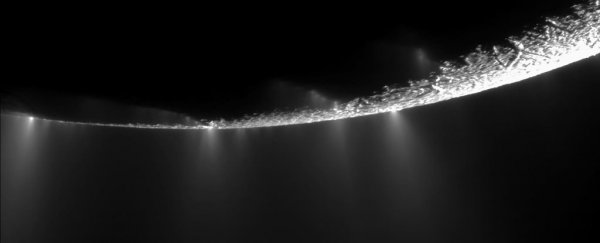We first spotted them 12 years ago. Jets of water vapour shooting into space through ice fissures at the south pole of Enceladus, a frosty moon orbiting Saturn.
That was in 2005 – long before NASA's Cassini dove into Saturn in scientific sacrifice – but the hydrothermal spray detected by the probe has never been fully explained. Now, we might have an answer, and it's one boosting hopes of one day finding life on Enceladus.
"Where Enceladus gets the sustained power to remain active has always been a bit of a mystery," says astrobiologist Gaël Choblet from the University of Nantes in France.
"[B]ut we've now considered in greater detail how the structure and composition of the moon's rocky core could play a key role in generating the necessary energy."
Scientists think the plumes that spout from Enceladus's frosty exterior emanate from a vast global ocean of salty water that lies underneath the ice shell enveloping the moon.
It's estimated this shell has an average thickness of up to 25 kilometres (15.5 miles) in depth, getting as thin as 1 kilometre around the south polar region where the hydrothermal spray is produced.
Tiny fragments of minerals in the plumes detected by Cassini suggest the salts and silica dust in the spray are formed through hot water reaching around 90°C (194°F) interacting with rock in Enceladus's rocky core.
But for that interaction to occur, there would have to be space within the core for the water to co-exist – it would have to be porous, perhaps even mushy.
"Whatever the core's composition in terms of rocks, it has to have water within it," Choblet explained to Leah Crane at New Scientist, "maybe 20 or 30 percent water."
In new simulations, the team found tidal motion generated by the moon's elliptical orbit of Saturn could heat up water inside Enceladus's core, due to friction produced as the liquid circulates and slides among rock fragments.
As the water rises in temperature (reaching 90°C, per the orange-coloured sections in the image below), it rises through the porous core, transferring heat to the global ocean in the form of lifting plumes, some of which end up melting Enceladus's icy core – ultimately escaping in icy jets released into space:
 (NASA/JPL-Caltech/Space Science Institute/LPG-CNRS/U. Nantes/U. Angers/ESA)
(NASA/JPL-Caltech/Space Science Institute/LPG-CNRS/U. Nantes/U. Angers/ESA)
"Water transport in the tidally heated permeable core results in hot narrow upwellings with temperatures exceeding 363 K," the researchers write in their paper, "characterised by powerful (1–5 gigawatt) hotspots at the seafloor, particularly at the south pole."
The heat and energy produced by the phenomenon would expel the plumes from the moon's polar regions – explaining why the heated ice shell is thinner there – and could ultimately help heat the ocean for potentially billions of years, the team hypothesises.
Previous research on Enceladus had suggested the plumes might be powered by radioactive decay of rocks in the moon's core.
If that were the case, though, the process might only have provided heat for millions of years – which possibly wouldn't be long enough for life to evolve and take hold in the temperate ocean buried beneath Enceladus's frozen mask.
But over a much longer timeframe – up to billions of years – it's possible life could find a way to make the most of such an opportunity.
"A warm global ocean with a lifetime of several billion years would be a great place for life to get going – it only took about 640 million years for life to evolve from microbe to mammal on Earth," planetary scientist Monica Grady from the Open University in the UK, who wasn't involved with the study, writes at The Conversation.
"Unfortunately, though, Enceladus itself may be quite young: a recent paper proposed that the moon might only have formed about 100 million years ago – is that a sufficiently long interval for life to have got going?"
Now, that is a very interesting question.
The findings are reported in Nature Astronomy.
